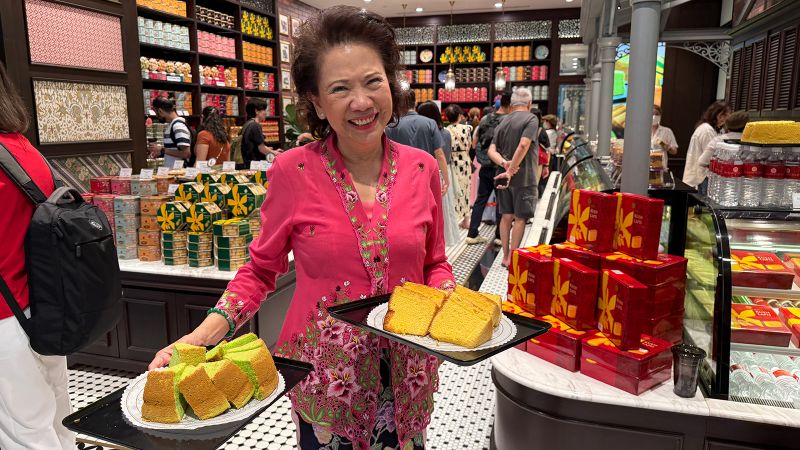In recent years, a surprising culinary sensation has emerged from Singapore: the fluorescent green pandan chiffon cake. This delightful and light dessert has become a ubiquitous presence in the daily lives of locals, with many rushing to grab a slice before work or purchasing a whole cake to celebrate friends’ birthdays. Its vibrant green color comes from the pandan plant, an ingredient revered in Southeast Asian cuisine, believed to have origins in Indonesia’s Moluccas Islands. Known for its subtle grassy, vanilla-like flavor, pandan has been cherished in cooking for generations.
The rise of the pandan chiffon cake in Singapore began during the 1970s, according to food historian Khir Johari. Over the decades, this beloved dessert has proliferated throughout the city, becoming a common offering in both small family-run bakeries and luxurious restaurants. One bakery, in particular, played a pivotal role in popularizing the pandan chiffon cake across Singapore: Bengawan Solo. Founded in 1979 by Anastasia Liew, the first Bengawan Solo store started as a modest neighborhood shop where she baked cakes at home before needing to comply with local business licensing requirements.
Anastasia recalls her humble beginnings but readily acknowledges the bakery’s significant contribution to the popularity of pandan chiffon cake in Singapore. “I made it popular in Singapore,” she states proudly. Today, her establishment has grown exponentially, boasting over 40 outlets in a city with a population of approximately six million. The success story of Bengawan Solo is complemented by word-of-mouth advertising alongside notable endorsements from celebrity figures.
For instance, Singaporean Mandopop star JJ Lin famously presented a Bengawan Solo cake to his fellow judges on a popular Chinese singing competition about eight years ago. More recently, superstar Jay Chou highlighted his fondness for the cakes on Instagram, drawing attention from his fans. These gestures have undoubtedly bolstered the bakery’s reputation and visibility.
While Bengawan Solo offers an array of traditional items, including kueh lapis (layered cake), ondeh ondeh (glutinous rice balls), and pineapple tarts, the pandan chiffon cake remains its most iconic product. In a remarkable display of the cake’s popularity, the bakery sold around 85,000 whole pandan chiffon cakes in the past year, priced at 22 Singapore dollars (approximately $17), resulting in an impressive revenue of 76 million Singapore dollars (about $57 million) across all product lines—an 11% increase from the previous year. However, Henry, Anastasia’s son and company director, acknowledges that the local market might be reaching saturation. Consequently, the bakery is exploring options to tap into the gift-giving culture of Asia, focusing on unique packaging to attract customers further afield.
A testament to the cake’s allure is the presence of Bengawan Solo in Singapore’s Changi Airport, which boasts five stores—the most in any airport worldwide. Travelers often purchase these cakes, as they have become a sought-after gift in cities like Hong Kong, where demand has given rise to a secondary market on platforms like Facebook Marketplace and Carousell. Henry reveals that airport sales now account for over half of Bengawan’s total revenue, with travelers from Hong Kong, mainland China, Taiwan, South Korea, and Japan showing a particular preference for their products.
As the company contemplates potential international expansion, it faces challenges, primarily the high rental costs in locations such as Hong Kong. Additionally, maintaining quality is a priority; the bakery sources most ingredients locally and obtains its pandan leaves from Malaysia. Despite such hurdles, the global appreciation for pandan appears to be flourishing. In Hong Kong, for example, other bakeries are capitalizing on this trend, promoting pandan-based products in shopping malls. Internationally, cities like New York and San Francisco have also seen an upsurge in desserts featuring pandan, reinforcing its growing popularity outside of Asia.
As Keri Matwick, a food culture researcher at Nanyang Technological University, notes, the surge of interest in Asian desserts is coupled with a rising global inclination toward unique flavors such as matcha, ube, and now pandan. “Matcha has already set that precedent; something green is okay,” she reflects, suggesting that pandan may soon rise to become a celebrated star in the global culinary scene. With its exotic flavor and eye-catching appearance, pandan chiffon cake is positioned well to captivate audiences far beyond Singapore’s shores, inviting food enthusiasts around the world to experience its delightful taste and vibrant charm.



